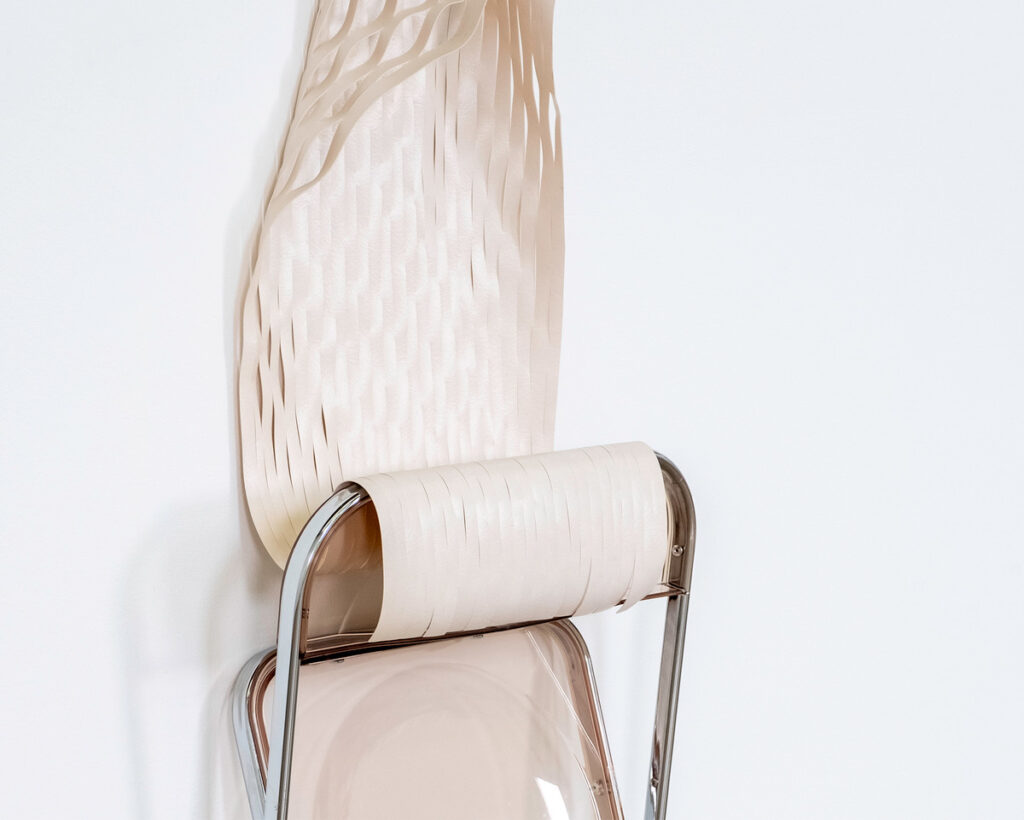22 JUNE – 02 AUGUST 2024
weight lifted
Accompanying exhibition text by Diana Sherlock
22 JUNE – 02 AUGUST 2024
weight lifted
Accompanying exhibition text by Diana Sherlock

SVEA FERGUSON, Knock off, 2024, PVC, REPLICA PLIA FOLDING CHAIR, STEEL, 66” x 20” x 8”
Within capitalist cycles of production and consumption, humans rarely consider the agency of objects and, even less so, the materials from which they are made. Yet it is through our relationships with material things, including other bodies, that we come to know the world and our place within it. Weight Lifted, an exhibition of sculptures and digital prints by Calgary artist Svea Ferguson, contemplates material agency—the potential of material things to act upon and affect their environments without human intervention.
A sculptor, Ferguson’s identity as an artist is reciprocally defined in relation to her materials and the identity of the art object, which she comes to know through its material transformation and display. She aligns her practice with “truth to materials”—the Modernist idea that every material has its individual qualities and should be used in ways that are most appropriate to its essential character. Truth to materials assumes the artist is the creator and has more agency than his material. Ferguson’s approach to her materials does not assume human exceptionality. Rather she considers the artwork a co-production between herself and the objects, materials, and matter she works with.
Ferguson’s material choices reveal her empathy for the in/animate world and her desire for more ethical material relations. She works with mass-produced functional objects and synthetic surfaces, linoleum, vinyl, and rubber, that are often faux finished. She is interested in the physical properties and lived identities of these things—how they were made and by whom, their intended and actual use, and why they end up, as they most often do, languishing in resale and recycling bins.
In Bare Bones and still standing still, the artist works with older Armstrong Flooring linoleum printed to look like a mosaic or textured stone. Ferguson is interested in the slippage of identity between the linoleum’s faux appearance and the physical properties that cause it to act differently than the original material it mimics. Her process is guided by the material and what it allows her to do. She cuts into the linoleum, freeing it from its degraded representation and usefulness, until the material reaches its structural limits. In Bare Bones only a skeleton of printed grey grout remains to hold it together. Ferguson allows the material to reveal its identity and agency through its physical properties, allowing it to behave naturally, rolled up on a dolly or unfurling off a vertical roll dispenser as they would be in a factory or a warehouse.
Outside the gallery context, these art objects could easily disappear back into the world of things. It’s easy for objects to escape our attention when they are not in use, but they are still present, and we are always still in relation to them. This sudden realization can be triggered by an encounter with an object, and can cause an uncanny feeling, when the familiar becomes strange, even threatening. This is the moment when we see the potential for an object to act in ways we did not expect, for it to become something else.
Knock off is the result of such an encounter. It is a reconstruction of a provisional arrangement of things in the artist’s studio that had escaped her attention, a piece of fishnet cut vinyl she had informally tacked to the wall that had become draped over a studio chair. The work had practically made itself but Knock off substitutes the studio chair with a reproduction of a Giancarlo Piretti’s Plia folding chair (1967). The chair was made with transparent polypropylene and a thin steel profile, designed to store flat on the wall when not in use—to hide in plain sight as had the arrangement of objects in the Ferguson’s studio. The Plia chair is an early example of invisible design, a ubiquitous trend where the design feels so natural it goes unnoticed, which increases the object’s power to influence its users to achieve maximum efficiency without them being aware of it.
Weightlifter, a sublime room-sized installation with an ambiguous object in the corner, stages an affective encounter with viewers who enter the space. It is the result of Ferguson working collaboratively with a heavy rubber material to make an open form that communicates the effects of tension, gravity, and resistance on all matter. One can sense Ferguson’s body in the body of the object in relation to the architecture. The artist’s absence is present while the object is waiting, perhaps for another encounter, and the opportunity for its identity to become entwined with our own.
Svea holds a Bachelor of Fine Arts (BFA) in drawing from the Alberta University of the Arts (formerly Alberta College of Art and Design) (2015). She was a recipient of the BMO 1st Art! Student Prize (2015) and the Horizon Alumni Award from AUArts (formerly ACAD) in 2017. Her work had shown in numerous exhibitions including The Holland Project, Reno, NV; Division Gallery, Toronto, ON; Arts Commons, Calgary, AB; The Esker Foundation, Calgary, AB; and most recently a solo exhibition at the Southern Alberta Art Gallery (SAAG) in Lethbridge, AB. Her work is held in the collections of The Banff Centre for Art and Creativity, TD Canada Trust and numerous private collections.
Diana Sherlock is an independent curator, visual arts writer, and curatorial consultant with CMCK Public Art in Calgary. She has published over eighty texts in gallery catalogues and contemporary art journals internationally and is the editor of the artist monographs Rita McKeough: Works and Larissa Fassler: Viewshed.

